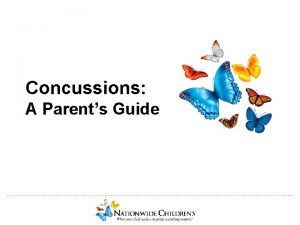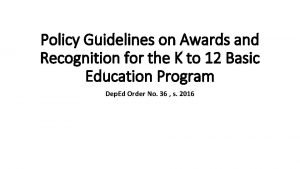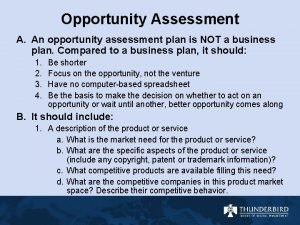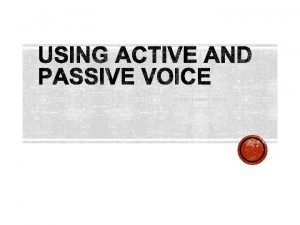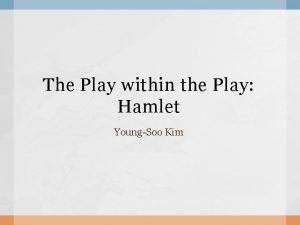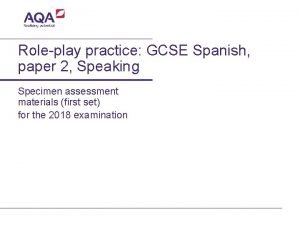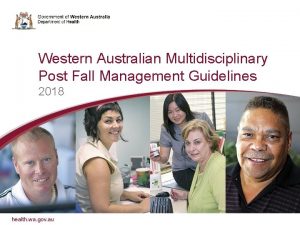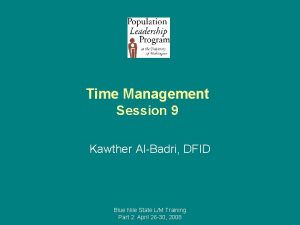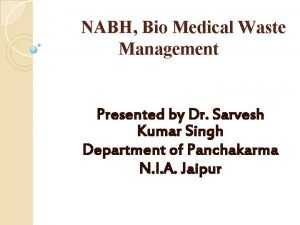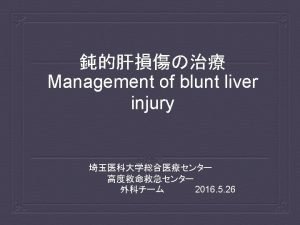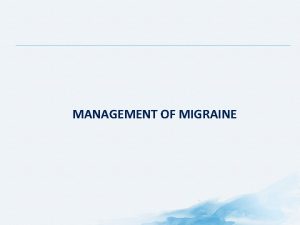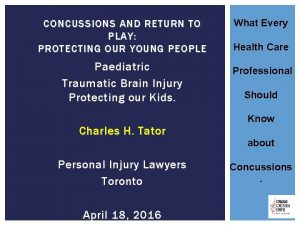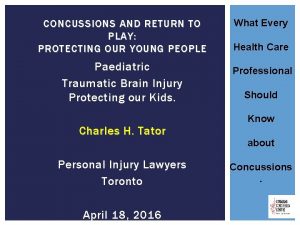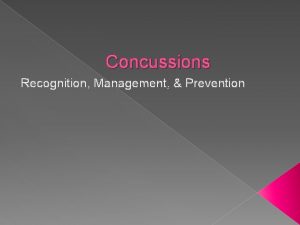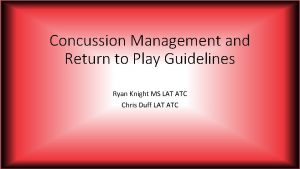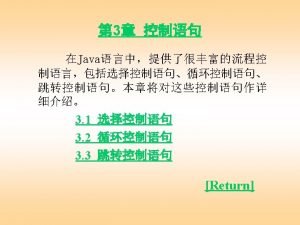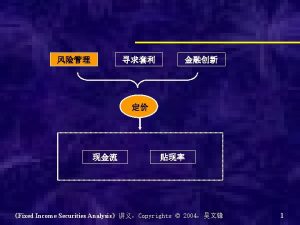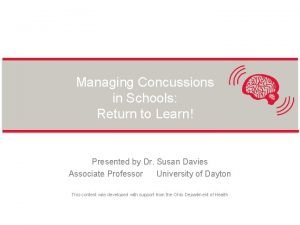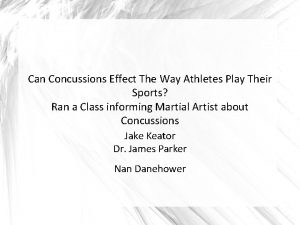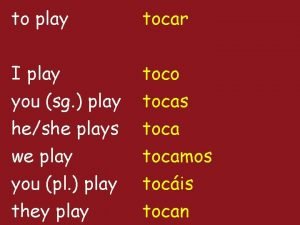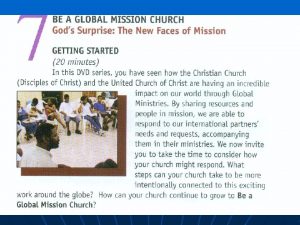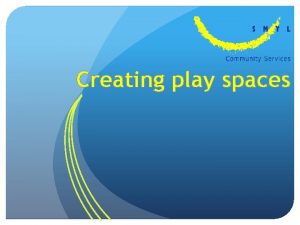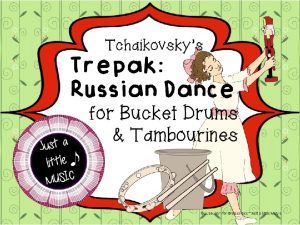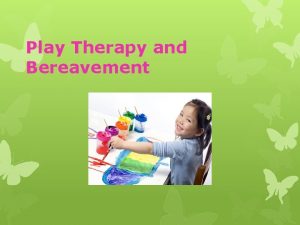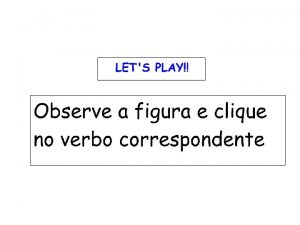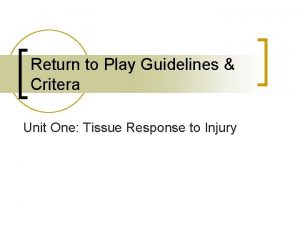Concussions Recognition Assessment Management Return to Play Guidelines





















- Slides: 21

Concussions: Recognition, Assessment, Management, & Return to Play Guidelines Stan Skolfield, ATC, CSCS

My Background � Athletic Trainer/Strength Coach with 20 years experience ◦ USM, Boston Red Sox, various high schools ◦ Covered almost every sport ◦ Coordinated medical coverage for all MMA events in Maine �Travis Wuiff � Currently the OA Performance Center/Parisi Speed School Manager � Gorham resident and son plays football

What Is A Concussion? �A Concussion is a traumatic brain injury that alters the way the brain functions. Even the slightest shaking or jarring can potentially cause a disruption to the neurological function of the brain.

Signs and Symptoms � Loss of Consciousness � Headache � Confusion � Dizziness � Sensitivity to Light or Sound � Irritability � Memory Loss � Nausea � Tinnitus (Ringing In The Ears) � Pupillary Changes (dilated, unequal) � Loss of Coordination or Balance � Feeling Sluggish � Slower Reaction Time

Signs and Symptoms cont… � Unusual lumps or depressions on the head � Blood or other fluids in the ears or nose � Profuse bleeding from the head � Seizures � Impaired breathing � Impaired vision

Concussion; Signs & Symptoms Table 2: Selected acute & delayed signs & symptoms suggestive of concussion Cognitive Somatic Affective Sleep Disturbances Confusion Anterograde amnesia Retrograde amnesia Loss of consciousness Disorientation Feeling “in a fog”, “zoned out” Vacant stare Inability to focus Delayed verbal & motor responses Slurred/incoherent speech Excessive drowsiness Headache Dizziness Balance disruption Nausea/vomiting Visual disturbances (photophobia, blurry/double vision) Phonophobia Emotional lability Irritability Fatigue Anxiety Sadness Trouble falling asleep Sleeping more than usual Sleeping less than usual Team Physician Consensus Conference, Herring et al, 2011

Second Impact Syndrome � Second Impact Syndrome (SIS) is caused by rapid swelling of the brain tissue whenever an athlete suffers a secondary concussive impact after the symptoms of the first concussion have yet to resolve. � The brain needs adequate time to heal from an injury such as a concussion. � A second impact is often fatal, and those who do survive are severely disabled from this catastrophic injury. Extra caution should be taken before allowing an athlete to return to play prematurely.

Primary Assessment � Must be able to recognize and interpret the S/S of a head injury � If an athlete is unconscious, ALWAYS assume injury to the neck as well

Primary Assessment cont… � Without moving the athlete, assess the airway � Athlete is breathing � Airway is obstructed � Observe for S/S of head and neck injury � Face color � Skin condition � Pulse � Breathing � Pupils � Edema (swelling) � Ecchymosis (bruising) � Deformity

Secondary Assessment � Assess � What mental orientation and memory is your name? � How old are you? � Where are you? � What game are you playing? � What is the score? � What month is it? � Who is president? � Ask to remember a series of numbers � After again 5 -10 minutes, ask the same questions

Secondary Assessment cont… � Test for “Eye signs” � Dilated and/or irregular pupils � Blurred vision � Inability for eyes to accommodate rapidly to light variance � Inability for eyes to track smoothly

Secondary Assessment cont… � Balance � Stand Testing with eyes closed � Stand on one foot with eyes closed � Finger-to-Nose test � Babinski Test ◦ Reflex tested by running a pointed object along the bottom of the foot ◦ Normal response is toe flexion

Concussion Grades Grade 2 Grade I � � � No loss of Consciousness Symptoms resolve >15 minutes Remove from activity and assess every 5 minutes. ◦ (Take the helmet) � � With post concussion symptoms, disqualify from further activity. Symptom free after 15 minutes, athlete may return to activity • • Transient confusion but no loss of consciousness. Symptoms last <15 minutes. May include more severe symptoms such as memory loss, balance issues, nausea etc. Disqualify from activity and see physician as soon as possible. Grade 3 • Loss of consciousness. • Potential spinal cord issues. • Convulsions • Collapse of the cardiorespiratory system. • Activate EMS immediately.

Protocol � � Do not give athlete medication for a headache Clearance for return to play should be handled by a medical professional, preferably a sports medicine physician*. ◦ ◦ ◦ � On-field assessment of athlete. Contact parents as soon as possible. Contact referred physician of incoming athlete. Follow up with athlete upon return to school. Post-concussion Impact testing. Athlete can return to play once physician clears them, they are symptom free, and Im. PACT scores are back to baseline. Grade 1: ◦ Athletes can return to play if symptoms resolve <15 minutes after impact. � Grade 2: ◦ Athlete can only return to play after being evaluated by a team physician. � Grade 3: ◦ Call EMS immediately upon recognition of any Grade 3 Symptoms. ◦ Return to play protocol is to be determined by physician.

Criteria to Return to Play � Normal neurological function � Normal vasomotor functions (BP, pulse) � Normal balance � Free of headaches � Free of lightheadedness � Free of dizziness � Free of seizures � Functional test (jog, run, jump up and down, cut, spin)

Criteria to Return to Play: Mild Concussion � First Concussion ◦ Return to play if asymptomatic � Second Concussion ◦ Must be asymptomatic for 1 week � Third Concussion ◦ Terminate season ◦ May play next year if asymptomatic

Criteria to Return to Play: Moderate Concussion � First Concussion ◦ Must be asymptomatic for 1 week � Second Concussion ◦ Must be asymptomatic for 1 month � Third Concussion ◦ Terminate season ◦ May play next year if asymptomatic

Criteria to Return to Play: Severe Concussion � First Concussion ◦ Must be asymptomatic for 1 month � Second Concussion ◦ Terminate season ◦ May play next year if asymptomatic

Concussion Management Progression of Return to Play • Progression should be gradual, and that the time spent at each stage should be individualized (from Vienna Guidelines ’ 01, Zurich ‘ 09)

Home/School Activity � Athlete may need to stay home from school ◦ No TV, texting, electronic games, reading, loud music ◦ The brain needs rest! Could worsen symptoms � Notify teachers-school work may need to be modified ◦ Monitor symptoms; headache, inability to concentrate, dizziness ◦ Prioritize assignments-gradually increase workload

QUESTIONS? THANK YOU sskolfield@orthoassociates. com
 How long do concussions last
How long do concussions last Deped order 36 s. 2016
Deped order 36 s. 2016 Ohsaa eligibility rules
Ohsaa eligibility rules Opportunity recognition and opportunity assessment plan
Opportunity recognition and opportunity assessment plan I've got a friend we like to play we play together
I've got a friend we like to play we play together Play random play basketball
Play random play basketball Play by play
Play by play Play within the play hamlet
Play within the play hamlet Pki assessment guidelines
Pki assessment guidelines Different guidelines for effective student assessment
Different guidelines for effective student assessment Joint play assessment grades
Joint play assessment grades Role play assessment
Role play assessment Financial management chapter 8 risk and return
Financial management chapter 8 risk and return Fall prevention interventions
Fall prevention interventions Time management guidelines
Time management guidelines Bio medical waste
Bio medical waste East guideline
East guideline Raas
Raas Flood hazard area land use management guidelines
Flood hazard area land use management guidelines Pathophysiology of migraine slideshare
Pathophysiology of migraine slideshare Project cycle management
Project cycle management Restaurant management guidelines
Restaurant management guidelines
